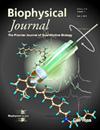GID4 Recognition of Pro/N-Degron Peptides: Conformational Selection and Induced Fit.
IF 3.2
3区 生物学
Q2 BIOPHYSICS
引用次数: 0
Abstract
The N-degron pathway is essential for protein quality control and cellular homeostasis. GID4, a subunit of the GID ubiquitin ligase, is the main recognition component of the Pro/N-degron pathway. It binds protein substrates through their N-terminal proline, but its binding model and recognition of non-proline residues remain unclear. In this study, we performed molecular dynamics (MD) simulations and binding energy calculations to explore GID4's binding with Pro/N-degron peptides and non-proline residues. Our analysis revealed that in its apo state, GID4's hairpin loops (L1, L2, L3, L4) facilitate alternating open-closed states in the binding pocket. This conformational change allows selective recognition of proteins with N-terminal degradation signals, followed by loop adaptation that secures the substrate. The binding process follows a combined mechanism of conformational selection and induced fit. Mutation of the N-terminal proline reduces its binding contribution but has minimal impact on interactions with other residues. These findings provide new insights into GID4's substrate recognition mechanisms, potentially aiding the regulation of protein degradation pathways.Pro/N-Degron肽的GID4识别:构象选择和诱导拟合。
N-degron通路对蛋白质质量控制和细胞稳态至关重要。GID4是GID泛素连接酶的一个亚基,是Pro/N-degron通路的主要识别组分。它通过蛋白质的n端脯氨酸结合蛋白质底物,但其结合模式和对非脯氨酸残基的识别尚不清楚。在这项研究中,我们通过分子动力学(MD)模拟和结合能计算来探索GID4与Pro/N-degron肽和非脯氨酸残基的结合。我们的分析表明,在载脂蛋白状态下,GID4的发夹环(L1, L2, L3, L4)促进结合口袋中交替的开闭状态。这种构象变化允许选择性识别具有n端降解信号的蛋白质,随后是确保底物的环适应。结合过程遵循构象选择和诱导配合的综合机制。n端脯氨酸的突变减少了其结合贡献,但对与其他残基的相互作用影响最小。这些发现为GID4的底物识别机制提供了新的见解,可能有助于调节蛋白质降解途径。
本文章由计算机程序翻译,如有差异,请以英文原文为准。
求助全文
约1分钟内获得全文
求助全文
来源期刊

Biophysical journal
生物-生物物理
CiteScore
6.10
自引率
5.90%
发文量
3090
审稿时长
2 months
期刊介绍:
BJ publishes original articles, letters, and perspectives on important problems in modern biophysics. The papers should be written so as to be of interest to a broad community of biophysicists. BJ welcomes experimental studies that employ quantitative physical approaches for the study of biological systems, including or spanning scales from molecule to whole organism. Experimental studies of a purely descriptive or phenomenological nature, with no theoretical or mechanistic underpinning, are not appropriate for publication in BJ. Theoretical studies should offer new insights into the understanding ofexperimental results or suggest new experimentally testable hypotheses. Articles reporting significant methodological or technological advances, which have potential to open new areas of biophysical investigation, are also suitable for publication in BJ. Papers describing improvements in accuracy or speed of existing methods or extra detail within methods described previously are not suitable for BJ.
 求助内容:
求助内容: 应助结果提醒方式:
应助结果提醒方式:


